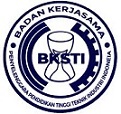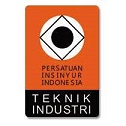Analisis Permintaan Tas Anak di UD Wijaya Menggunakan Metode Peramalan Time Series
Abstract
At this time, the Industry is more diverse and developing rapidly. Industrial development causes many companies to think of ways to survive and face fierce competition, which becomes a challenge for companies, especially for small MSME industries in their development stage. The establishment of this strategy is necessary to deal with changing market conditions as well as customers. Fulfillment of past demand is related to products (quantity and quality) and also raw materials and the increase in demand for a product varies. Consumer demand is uncertain, so methods that can minimize uncertainty are needed, one of which is the forecasting method. Forecasting uses historical data on sales demand and product usage so that it can be produced in the right quantity as well. UD Wijaya is one of the bag manufacturers. Produce bags continuously in constant quantities. This if not managed properly, will cause overstock and understock Therefore, this study uses forecasting methods to forecast the next 3 months, this study compares 4-time series forecasting methods Moving Average, Weighted Moving Average, Single Exponential Smoothing and Double Exponential Smoothing. The four methods compared the smallest MAD, MAPE, MSE, and MAPE values and the results in the next 3 months with a moving average of 3 as much as 240 pcs, 280 pcs, 280 pcs
Full Text:
PDFReferences
J. Li, “Forcasting of energy futures market and synchronization based on stochastic gated recurrent unit model,” Energy, vol. 213, 2020, doi: 10.1016/j.energy.2020.118787.
H. Dong, “A multifactorial short-term load forecasting model combined with periodic and non-periodic features - A case study of qingdao, China,” IEEE Access, vol. 8, pp. 67416–67425, 2020, doi: 10.1109/ACCESS.2020.2986031.
A. Yousefi, “Long-Term Electricity Price Forecast Using Machine Learning Techniques,” 2019 IEEE PES Innovative Smart Grid Technologies Asia, ISGT 2019. pp. 2909–2913, 2019. doi: 10.1109/ISGT-Asia.2019.8881604.
A. Leenatham, “Demand Forecasting Using Artificial Neural Network Based on Quantitative and Qualitative Data,” 2020 1st International Conference on Big Data Analytics and Practices, IBDAP 2020. 2020. doi: 10.1109/IBDAP50342.2020.9245614.
D. Didiharyono, “Forecasting with arima model in anticipating open unemployment rates in south sulawesi,” Int. J. Sci. Technol. Res., vol. 9, no. 3, pp. 3838–3841, 2020, [Online]. Available: https://api.elsevier.com/content/abstract/scopus_id/85084980224
L. Ranaldi, “CryptoNet: Using Auto-Regressive Multi-Layer Artificial Neural Networks to Predict Financial Time Series,” Inf., vol. 13, no. 11, 2022, doi: 10.3390/info13110524.
J. P. Marquez, “Ethanol Fuel Demand Forecasting in Brazil Using a LSTM Recurrent Neural Network Approach,” IEEE Lat. Am. Trans., vol. 19, no. 4, pp. 551–558, 2021, doi: 10.1109/TLA.2021.9448537.
C. C. Chen, “Comparison of Forcasting Ability between Backpropagation Network and ARIMA in the Prediction of Bitcoin Price,” Proceedings - 2019 International Symposium on Intelligent Signal Processing and Communication Systems, ISPACS 2019. 2019. doi: 10.1109/ISPACS48206.2019.8986297.
K. Cetin, “Steel Price Forcasting Using Long Short-Term Memory Network Model,” UBMK 2019 - Proceedings, 4th International Conference on Computer Science and Engineering. pp. 612–617, 2019. doi: 10.1109/UBMK.2019.8907015.
B. Wang, “Air Quality Forcasting based on Gated Recurrent Long Short-Term Memory Model,” ACM International Conference Proceeding Series. 2019. doi: 10.1145/3321408.3326656.
H. Wang, “Evaluation of multi-model current data in the East/Japan Sea,” 2020 3rd IEEE International Conference on Information Communication and Signal Processing, ICICSP 2020. pp. 486–491, 2020. doi: 10.1109/ICICSP50920.2020.9232090.
I. N. Permadi and D. B. Nisa, “A Model Experiment Design Using the Taguchi Method: A Case Study Of Making Concrete Roof,” J. Ris. Ilmu Tek., vol. 1, no. 1, pp. 36–44, 2023.
U. M. Sirisha, “Profit Prediction Using ARIMA, SARIMA and LSTM Models in Time Series Forecasting: A Comparison,” IEEE Access, vol. 10, pp. 124715–124727, 2022, doi: 10.1109/ACCESS.2022.3224938.
C. Jin, “Application and Optimization of Long Short-term Memory in Time Series Forcasting,” 2022 International Communication Engineering and Cloud Computing Conference, CECCC 2022. pp. 18–21, 2022. doi: 10.1109/CECCC56460.2022.10069825.
N. F. Gamayanti, “Application of fuzzy time series to forecast COVID-19 cases in Central Sulawesi,” AIP Conference Proceedings, vol. 2719. 2023. doi: 10.1063/5.0133299.
E. S. Barus, “Forcasting Plant Growth Using Neural Network Time Series,” 2019 International Conference of Computer Science and Information Technology, ICoSNIKOM 2019. 2019. doi: 10.1109/ICoSNIKOM48755.2019.9111503.
M. F. Valdez-Ávila, “CBR-foX:A generic post-hoc case-based reasoning method for the explanation of time-series forecasting,” CEUR Workshop Proceedings, vol. 3389. pp. 246–250, 2022. [Online]. Available: https://api.elsevier.com/content/abstract/scopus_id/85159773067
H. Shu, “A Study of MLP-Mixer with FFT for Short Term Wind Speed Forecasting,” Proceedings of SPIE - The International Society for Optical Engineering, vol. 12451. 2022. doi: 10.1117/12.2656464.
M. L. Ran, “Short-term logistics demand forecasting based on EEMD-LMD-LSTM-LEC deep learning model,” Kongzhi yu Juece/Control Decis., vol. 37, no. 10, pp. 2513–2523, 2022, doi: 10.13195/j.kzyjc.2021.0413.
Y. J. Guan, “Financial time series forecasting model based on CEEMDAN-LSTM,” CTISC 2022 - 2022 4th International Conference on Advances in Computer Technology, Information Science and Communications. 2022. doi: 10.1109/CTISC54888.2022.9849780.
G. Filhaq, S. Aprianto, and H. Alfianto, “Design of Smart Locker Door Using Quality Function Deployment Based on ATMega 2560 Microcontroller,” J. Ris. Ilmu Tek., vol. 1, no. 1, pp. 25–35, 2023.
F. Pohan, I. Saputra, and R. Tua, “Scheduling Preventive Maintenance to Determine Maintenance Actions on Screw Press Machine,” J. Ris. Ilmu Tek., vol. 1, no. 1, pp. 1–12, 2023.
V. C. Dewi, V. Amrizal, and F. E. M. Agustin, “Implementation of Adaptive Neuro-Fuzzy Inference System and Image Processing for Design Applications Paper Age Prediction,” J. Ris. Ilmu Tek., vol. 1, no. 1, pp. 45–57, 2023.
T. M. Sari and W. Dini, “Risk Assessment and Mitigation Strategy in The Halal Broiler Supply Chain,” J. Ris. Ilmu Tek., vol. 1, no. 1, pp. 13–24, 2023.
DOI: http://dx.doi.org/10.24014/jti.v9i2.22745
Refbacks
- There are currently no refbacks.
Copyright (c) 2023 Nurma Yogi Adi Lesmana, Dzakiyah Widyaningrum, Yanuar Pandu Negoro

This work is licensed under a Creative Commons Attribution-NonCommercial-ShareAlike 4.0 International License.
Jurnal Teknik Industri
P-ISSN 2460-898X | E-ISSN 2714-6235
Published by:
Industrial Engineering Department
Universitas Islam Negeri Sultan Syarif Kasim Riau, Indonesia
Office Address:
H.R. Soebrantas KM 15.5, Tampan, Pekanbaru, Riau, Indonesia 28293
email: jti.fst@uin-suska.ac.id
Indexed by:
JTI : Jurnal Teknik Industri under a Creative Commons Attribution-NonCommercial-ShareAlike 4.0 International License.

















